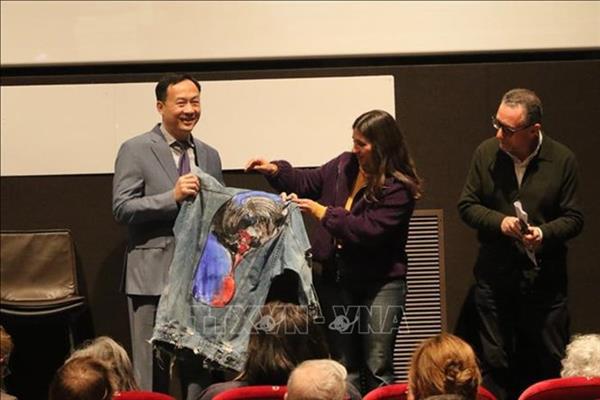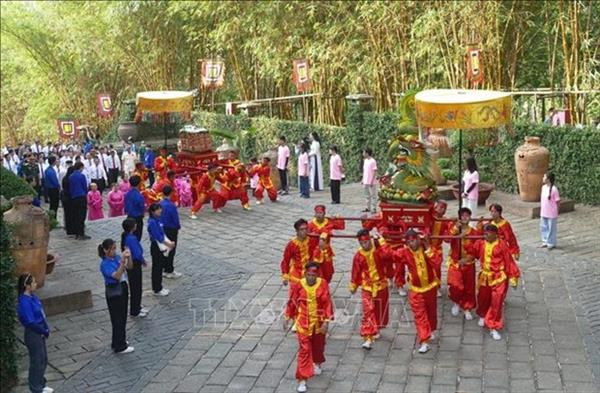Hanoi, April 12 (VNA) - Archeologists announced that prehistoric people living in Vietnam knew how to use hand-axes 700-800 thousand years ago. The remarks were made during a presentation of the preliminary results of the archaeological study of An Khe Town in the Central Highlands province of Gia Lai.
Researchers from the Vietnam Institute of Archaeology (VIA) and the Vietnam Academy of Social Sciences on April 11 reported on their excavation and showcased remarkable artifacts they have collected.
Nguyen Gia Doi, PhD, vice director of VIA, said they started excavating in late 2014. Technical and financial support from Russia’s Novosibirsk Institute of Archaeology and Ethnography made the project possible. The joint project investigating this site will run until 2019.
“The local people exploited stone from the mountains, exposing the vestige,” he said. “We visited and examined many times. Then we decided to excavate trenches at the Go Da and Roc Tung sites.”
Early this year, they collected 58 stone artifacts and 25 pieces of tektite. Stone artifacts collected include nine picks, five choppers, nine scrappers, two hammer stones, six flaked tools, three amorphous cored tools, 12 flakes, and 12 stone cores.
Tektites are gravel-size bodies composed of black, green, brown or gray natural glass formed from terrestrial debris ejected during meteorite impacts.
Due to the properties of tektites, scientists often use them to estimate dates for artifacts found in the same stratigraphic layer.
Tektites in Vietnam from the Australian – Indochinese field have previously been estimated to be around 700-800 thousands years old.
“That’s why our preliminarily assessment is that the artifacts are associated with Homo erectus, an ancestor to modern humans which arose at least 1.8 million years ago,” said Doi.
Geographically, this is a transitional area from the highlands to the delta-coastal region in central Vietnam. From the point of view of human geography, this is a long-standing residential area of Bahnar people speaking a language in the Mon-Khmer linguistic family.
“All sites have a single, intact cultural layer with stone objects. No sign of kitchen, tomb or human remains yet,” he said.
Doi supposed that no traces of humans were found because the archaeological site is outdoors, where organic matter would be destroyed easily. “Until now, we have only found Palaeolithic human bones in caves, where they can be preserved better,” he said.
This finding added evidence about the earliest Vietnamese history known. The excavation and research have just begun. It’s hoped that there will be new findings during subsequent excavations, said Nguyen Xuan Thang, Director of the VASS.
“For the first time, Vietnamese archaeologists have discovered tektites dating from 700-800 thousands years ago, together with the early Palaeolithic artifacts. This is a turning point in our awareness about the dawn of national history.”
The findings will supply materials to compile national history, contribute more objects to be displayed at museums, and provide the foundation to develop a plan for protecting and developing cultural tourism in the Central Highlands, he said.
Results of the excavation also contradict the view that only prehistoric Western people used bifaced hand axes, while prehistoric Eastern people had choppers and chopping tools.
Vietnamese researchers intend to organise an international conference to announce investigation results and to consult foreign experts about protecting the site and further research.
Researchers from the Vietnam Institute of Archaeology (VIA) and the Vietnam Academy of Social Sciences on April 11 reported on their excavation and showcased remarkable artifacts they have collected.
Nguyen Gia Doi, PhD, vice director of VIA, said they started excavating in late 2014. Technical and financial support from Russia’s Novosibirsk Institute of Archaeology and Ethnography made the project possible. The joint project investigating this site will run until 2019.
“The local people exploited stone from the mountains, exposing the vestige,” he said. “We visited and examined many times. Then we decided to excavate trenches at the Go Da and Roc Tung sites.”
Early this year, they collected 58 stone artifacts and 25 pieces of tektite. Stone artifacts collected include nine picks, five choppers, nine scrappers, two hammer stones, six flaked tools, three amorphous cored tools, 12 flakes, and 12 stone cores.
Tektites are gravel-size bodies composed of black, green, brown or gray natural glass formed from terrestrial debris ejected during meteorite impacts.
Due to the properties of tektites, scientists often use them to estimate dates for artifacts found in the same stratigraphic layer.
Tektites in Vietnam from the Australian – Indochinese field have previously been estimated to be around 700-800 thousands years old.
“That’s why our preliminarily assessment is that the artifacts are associated with Homo erectus, an ancestor to modern humans which arose at least 1.8 million years ago,” said Doi.
Geographically, this is a transitional area from the highlands to the delta-coastal region in central Vietnam. From the point of view of human geography, this is a long-standing residential area of Bahnar people speaking a language in the Mon-Khmer linguistic family.
“All sites have a single, intact cultural layer with stone objects. No sign of kitchen, tomb or human remains yet,” he said.
Doi supposed that no traces of humans were found because the archaeological site is outdoors, where organic matter would be destroyed easily. “Until now, we have only found Palaeolithic human bones in caves, where they can be preserved better,” he said.
This finding added evidence about the earliest Vietnamese history known. The excavation and research have just begun. It’s hoped that there will be new findings during subsequent excavations, said Nguyen Xuan Thang, Director of the VASS.
“For the first time, Vietnamese archaeologists have discovered tektites dating from 700-800 thousands years ago, together with the early Palaeolithic artifacts. This is a turning point in our awareness about the dawn of national history.”
The findings will supply materials to compile national history, contribute more objects to be displayed at museums, and provide the foundation to develop a plan for protecting and developing cultural tourism in the Central Highlands, he said.
Results of the excavation also contradict the view that only prehistoric Western people used bifaced hand axes, while prehistoric Eastern people had choppers and chopping tools.
Vietnamese researchers intend to organise an international conference to announce investigation results and to consult foreign experts about protecting the site and further research.
VNA/VNP

















